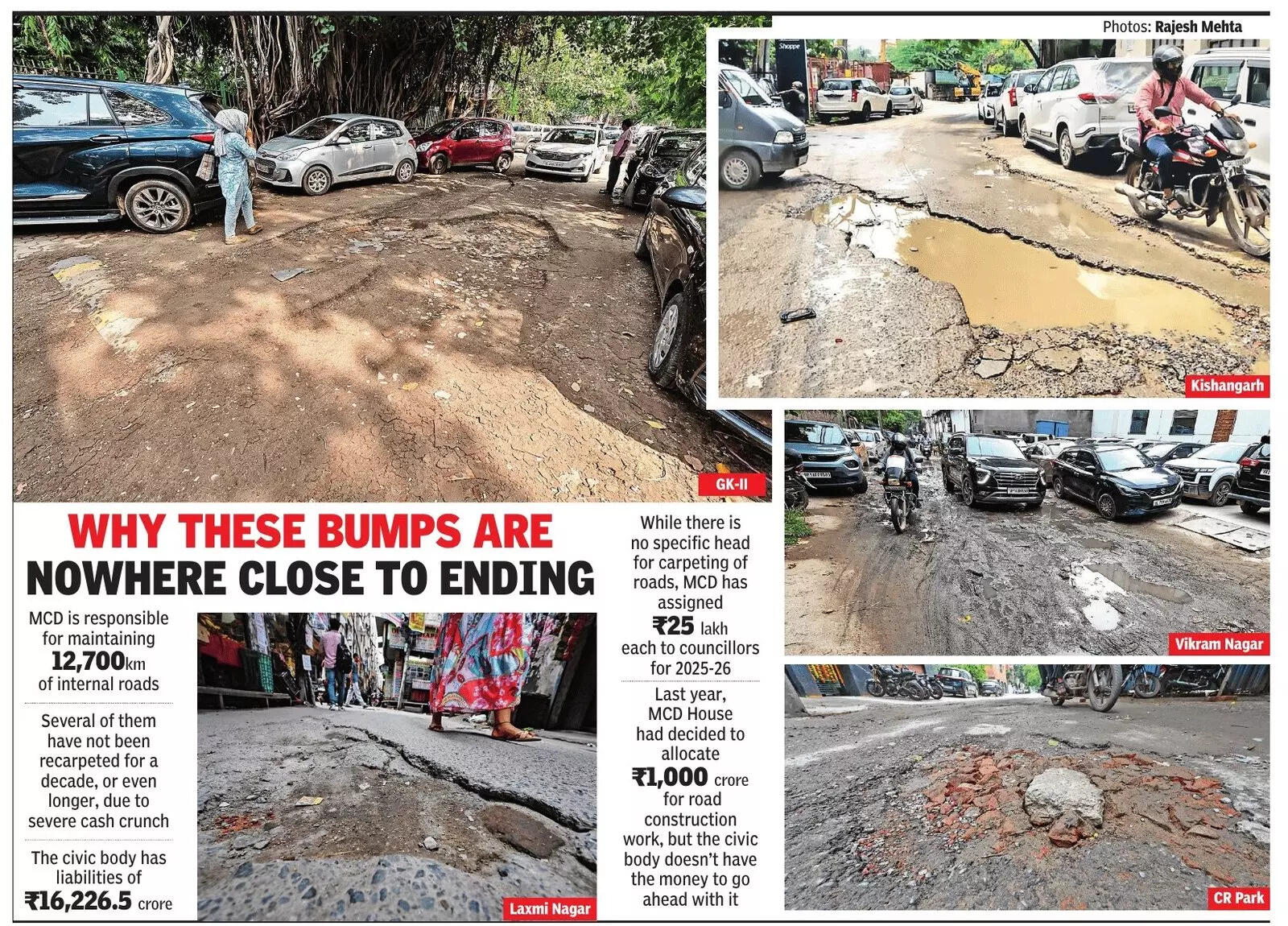
NEW DELHI: The state of internal roads in the city has received little attention over the years. With money tight and no specific budget head under which roads can be redeveloped, the Municipal Corporation of Delhi hasn’t been able to have the existing roads re-carpeted for a decade now. The funds allocated for the purpose aren’t adequate enough to make a significant difference and the select roads that got a new surface benefited from the MLA local area development fund or a state govt scheme.
Until 2018, approximately Rs 200 crore was allocated annually for road development in residential colonies, unauthorised regularised settlements, resettlement colonies and urban villages.
Poll
Do you believe the Municipal Corporation of Delhi is effectively managing road maintenance?
However, in 2018, the AAP-led state govt stopped allocating funds but introduced schemes such as Mukhyamantri Sadak Punarnirman Yojna, Delhi Village Development Board and depended on MLALAD funds for road carpeting, among other requirements. “These schemes did little to fulfil the purpose because the sanctioning process was lengthy,” said Neha Puri, president, Green Park Extension RWA. “In our colony, we applied for the carpeting of over 30 roads under the MLALAD scheme. But it’s been 15 years since carpeting was done. To date, only three roads were constructed last year and there are places in the colony where literally no road exists and incidents of senior citizens falling and getting hurt have become normal. It has been some time since BJP took over the state govt and MCD, but the condition of internal roads remains the same.” MCD officials claimed to have assigned funds of up to Rs 25 lakh to councillors for ward development in addition to the ward-wise funds granted for repair of roads. “In the ongoing mega sanitation drive, Rs 3 lakh has been given for repairing potholes along with repair materials,” said an official.

Given MCD’s liabilities of Rs 16,226.5 crore, including loans from Delhi govt and outstanding payments to contractors, assigning money for road revamp is not feasible. MCD is responsible for maintaining 12,700km of roads, and many of them, especially colony roads, are suffering, as evidenced by TOI’s visit to Green Park Extension, Laxmi Nagar, Chittaranjan Park, Greater Kailash II and areas in central Delhi. Mayor Raja Iqbal Singh pleaded that his party had only assumed charge a few months ago. “We are pursuing funds hard from the MLAs through MLALAD scheme. Every ward is also expected to get Rs 1 crore under the Chief Minister’s Development Fund. These will surely help,” Singh said. At CR Park, the bitumen layer has disappeared at several places on the stretch between H and G blocks. In 2023, MCD resorted to temporary repairs, filling the holes with debris, which only “worsened the situation”, according to a resident. PK Paul, former member, East Pakistan Displaced Persons Colony, stated that the road has made driving difficult. People living near Shiv Mandir and Market II had similar complaints about conditions remaining unchanged despite numerous complaints to MCD and area councillors. In adjacent GK II, the road conditions are equally bad. Residents near KR Mangalam School highlighted how schoolchildren were forced to navigate pothole-ridden roads daily, sometimes suffering accidents. “When the roads flood with rainwater, it is hard to see the potholes and the chances of falling are high,” said Sanjay Rana, secretary, GKII Residents’ Association. “We complained several times, but all MCD did was put malba in the potholes a year ago. Of course, this got washed away in no time, and we were back to square one.” In central Delhi, the narrow lane near Bal Bhawan and running alongside the Delhi Transco Limited office is heavily used because it connects many govt offices. “I work nearby and use this road to park my car. Over the course of three years, I have never seen it getting re-carpeted or the potholes being repaired. Ideally bitumen road should be recarpeted every 5-7 years,” said one office goer. But an official countered the public expectations about road revamp every five years by saying, “The fact is that not all roads require periodic carpeting, especially those that are well-maintained.” A similar picture plays out on Indraprastha Marg, leading up to the PWD HQ near ITO. Other parts of the city are equally impacted. Ajay Gupta, who has lived in Laxmi Nagar for the past 35 years and is the RWA president, said, “Whenever we complain, we are told MCD doesn’t have money. The councillors tell us their hands are tied when it comes to repairing the roads.” He pointed to Gali No. 11, where a fruit seller was struggling to push his cart along the uneven, pebbly surface. The gateway that joyfully announces ‘Welcome to Pandavnagar’ leads to a patchy road that residents say has remained in a decrepit state for two years. Indra Mani Gujral, president, Pandavnagar RWA, pointed at the excavated patches left unfilled and the gravel and mud making it difficult for two-wheelers. “These old galis were re-carpeted years ago. When we do maintain the roads, the money comes from our collective pockets,” he sighed.





